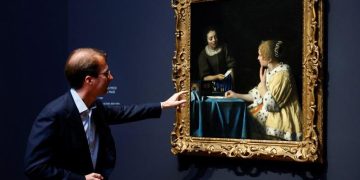Paul Allen, the late co-founder of Microsoft, was not only known for his groundbreaking role in the tech world but also for his exceptional taste and passion for collecting rare art and historical artifacts. Over the years, Allen’s collection grew to become one of the most celebrated and valuable assemblages of art, manuscripts, and rare objects, leading to a series of high-profile auctions that captured global attention. But what made these items so unique, and why did they become “dream pieces” at international auctions? Let’s explore the reasons behind the astronomical success of Paul Allen’s collection in the world of fine art and historical collectibles.
1. A Visionary Collector with a Deep Understanding of Art and History
Paul Allen’s approach to collecting was deeply rooted in his intellectual curiosity and his desire to preserve pieces that not only held immense artistic value but also told stories of human history and culture. Unlike many collectors who might focus purely on one specific category—whether it be impressionist paintings, ancient artifacts, or 20th-century modern art—Allen’s collection spanned a wide range of periods and genres.
He was not just an investor in art; he was a connoisseur with a genuine passion for understanding the cultural and historical significance behind each piece. His collection reflected his belief that art and history were interconnected, and that each object in his collection contributed to a broader narrative of human achievement.
This vision elevated his collection beyond just valuable assets to pieces that spoke to the collective human experience. As a result, when his collection went up for auction, it attracted attention from collectors, curators, and institutions alike, each eager to own a part of history or to acquire an object with immense intellectual and cultural weight.
2. The Uniqueness and Rarity of the Artworks and Artifacts
One of the main reasons Paul Allen’s collection became a global sensation was due to the sheer uniqueness and rarity of many of the pieces. Allen managed to acquire works and artifacts that few collectors, even those with vast financial resources, could ever dream of obtaining. His collection included works by renowned artists like Vincent van Gogh, Gustav Klimt, Paul Cézanne, and Edvard Munch, as well as rare manuscripts, scientific instruments, and historical documents. These pieces were not just valuable because of their inherent beauty or significance; they were rare, often one-of-a-kind objects that offered something distinctive to the market.
For example, Allen’s collection featured “The Scream” by Edvard Munch, a world-famous painting that generated massive global interest when it was auctioned in 2018. However, it was more than just the fame of the artist that made these pieces so compelling. Allen had a keen eye for acquiring works that were not only culturally important but also rare in terms of their provenance (their history of ownership) or their status within the artist’s body of work. This rarity is key to the auction world’s “dream pieces,” where the combination of history, provenance, and condition can create extraordinary demand and immense value.
3. Unprecedented Auction Results
In 2022, a significant portion of Paul Allen’s collection was auctioned off by Christie’s, generating some of the highest sales figures ever seen in the art market. The Paul Allen Collection Auction exceeded $1.5 billion, with individual pieces achieving record-breaking prices. For instance, “The Card Players” by Cézanne was sold for $250 million, making it one of the most expensive paintings ever sold at auction.
This extraordinary success highlighted several important factors that drove Allen’s collection to the top of the auction world:
- Prestige: Paul Allen was a figure of immense cultural prestige, and his ownership of these items added an additional layer of allure. Items that had once belonged to someone of Allen’s status became symbols of power and exclusivity. The historical connection to such an influential figure enhanced their desirability.
- The Provenance Factor: Provenance refers to the documented history of ownership of an artwork. Collectors pay a premium for items that have been owned by notable figures or have significant historical importance. Allen’s collection had impeccable provenance, with many pieces having been sourced from esteemed dealers and private collections, making them particularly desirable.
- Market Demand: The auction results also reflected broader trends in the global art market. The high demand for rare, historically significant pieces has only increased in recent years, driven by the growing wealth of collectors, museums, and institutions worldwide.
4. The Cultural and Educational Impact of the Collection
Allen’s collection was not just a financial investment—it was also an educational and cultural investment. He believed that art and artifacts should be shared with the public to educate and inspire future generations. In 2019, a portion of his collection was displayed at the Seattle Art Museum, offering the public a rare opportunity to experience these masterpieces in person. This accessibility further amplified the collection’s value, making it not only coveted by private collectors but also respected by institutions and scholars.
Allen’s commitment to education was evident in his approach to stewardship. He worked closely with experts and curators to ensure that his collection was preserved in its best possible condition and that its history was well-documented. In this way, the collection’s impact extended beyond the confines of private ownership to become a source of public knowledge and cultural enrichment.
5. The Tech Industry’s Affluence and the Global Auction Ecosystem
Paul Allen’s position as a co-founder of Microsoft gave him a unique financial advantage in the world of collecting. The immense wealth generated by the tech industry has resulted in a new class of collectors who are willing to spend significant sums of money on rare art and historical artifacts. Allen was part of this new wave of collectors who saw art not only as a financial asset but also as an opportunity for personal enrichment and intellectual exploration.
The increase in tech industry wealth has driven competition for rare pieces at global auctions, as tech moguls and investors seek to diversify their portfolios beyond traditional assets like real estate and stocks. This trend has fueled a bidding frenzy for top-tier art, and Paul Allen’s collection, with its unmatched quality and scope, fit perfectly into this ecosystem. When his collection went up for auction, it attracted global attention not only for the quality of the items but also because of the increasing competition among high-net-worth individuals and institutions vying for such coveted pieces.

6. The Timeless Nature of the Artworks and Artifacts
Another reason why Paul Allen’s collection became so highly sought after was the timeless nature of the pieces. Rare art and historical artifacts possess a certain transcendence—they are not simply trendy objects that will fall out of fashion. Instead, they have a lasting cultural significance that endures through generations.
For example, Allen’s Gustav Klimt painting, Portrait of Adele Bloch-Bauer II, which fetched over $150 million at auction, represents a moment in history that transcends the artist’s time and continues to captivate audiences today. Similarly, his acquisition of rare historical documents, such as the manuscript of the “Codex Leicester” by Leonardo da Vinci, connected the worlds of science, art, and innovation, making these pieces not only historically significant but also timeless.
In the auction world, items that carry with them a sense of timelessness—whether through their artistry, innovation, or historical importance—are considered “dream pieces” because they remain desirable for generations, increasing their value over time.
7. The Legacy of a Visionary Collector
Paul Allen’s legacy as a collector goes beyond just the extraordinary pieces he acquired. His passion for preserving history, understanding art, and sharing cultural treasures with the world has left an indelible mark on the art world. His collection was not merely about amassing wealth or status; it was about curating objects that embodied the creativity, achievement, and intellectual spirit of humanity.
In many ways, Allen’s collection represents the epitome of what makes a truly great collection. It is not just about financial value; it is about the stories these pieces tell, the cultures they represent, and the history they have witnessed. As a result, when these pieces were made available for auction, they became “dream pieces” not just for their intrinsic worth but for their historical significance and the cultural narrative they carried with them.
Conclusion: The Enduring Appeal of Paul Allen’s Collection
The rare art and historical artifacts collected by Paul Allen have become “dream pieces” at global auctions because of their unique combination of rarity, cultural significance, impeccable provenance, and timeless value. Allen’s visionary approach to collecting, his commitment to preserving and sharing his collection, and the exceptional quality of the items have transformed his holdings into some of the most coveted pieces in the world.
Ultimately, the success of Paul Allen’s collection at auction underscores the growing global demand for rare, historically rich art and artifacts. For future generations of collectors, Allen’s collection will continue to serve as a benchmark for what it means to curate a collection of cultural significance and enduring value.

















































